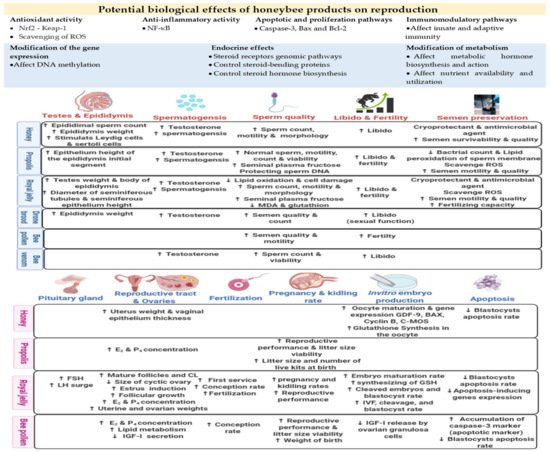1000/1000
Hot
Most Recent

Honeybee products have positive effects on the reproductive performance of mammals. Many honeybee product constituents are biologically active, with antioxidant, antimicrobial, antiviral, anti-inflammatory, immunomodulatory, antifungal, wound-healing, and cardio-protective properties.

| Animal Species | Treatment/Honeybee Product | Result | Suggested Mode of Action |
|---|---|---|---|
| Rats [25] | 1 mL/100 g BW of honey for 65 days |
|
|
| Rats [22] | Drinking 5% solution of Palestinian honey for 20 days |
|
|
| Rats [23] | 0, 0.2, 1.2, and 2.4 g/kg BW/day of Malaysian honey for 4 weeks |
|
|
| Rats [24] | 1.0 mL/100 g BW/day of Gelam honey for 60 days |
|
|
| Rats [28] | 2.5%, 5%, 7.5%, 10%, and 12.5% of propolis extract for 18 days |
|
|
| Rabbits [29] | 0, 0.25, 0.50, 0.75, 1.0, and 1.25 g/kg diet of propolis for 94 days |
|
|
| Rabbits [30] | 0.5 and 1 g/animal/day of Egyptian propolis for 6 weeks during summer months |
|
|
| Rabbits [14] | 150 mg/kg diet of vitamin E or propolis for 10 consecutive weeks during summer months |
|
|
| Pre-pubertal rabbits [31] | 15 mg/kg BW of propolis with/without 200 mg royal jelly + 0.25 mL bee honey |
|
|
| Rats [32] | 3, 6, and 10 mg/kg BW/day of Brazilian green propolis extract for 56 days |
|
|
| Rats [33] | 1 g/kg BW of royal jelly with or without hydrogen peroxide (0.5%) in drinking water for one month |
|
|
| Pups [34] | 125, 250, and 500 mg/day/kg diet of royal jelly proteins |
|
|
| Rabbits [35] | 0, 50, 100, and 150 mg/kg BW of Chinese royal jelly |
|
|
| Pre-pubertal rabbits [36] | 0.25 mL honey, 200 mg royal jelly, and 200 mg royal jelly + 0.25 mL honey |
|
|
| Sheep [37] | 10, 15, and 20 mg/kg diet of apistimul preparation (drone brood) for 95 days |
|
|
| Pigs (junior boars) [38] | Parenteral injection with alcohol extracts of the drone brood |
|
|
| Rabbits [39] | Injection of 0.1, 0.2, and 0.3 mg/rabbit of bee venom twice weekly for 20 weeks |
|
|
| Rabbits [40] | 0, 100, 200, and 300 mg of bee pollen/kg BW |
|
|
| Animal Species | Treatment/Honeybee Product | Result | Suggested Mode of Action |
|---|---|---|---|
| Ovariectomized rats a model for menopausal symptoms in women [44] |
0.2, 1.0, and 2.0 g/kg/day of Tualang honey for 2 weeks |
|
|
| Rabbits and offspring [51] | 150 and 300 mg/kg diet/day of bee pollen and/or propolis (Bp + Pro) three times a week along eight parities |
|
|
| Rabbits [52] | 0.2 g/kg BW of bee pollen and/or propolis compared with 35 mg/kg BW prebiotic (inulin and/or MOS) |
|
|
| Rats [53] | 3 and 5 g/kg feed mixture of rape seed bee pollen |
|
|
| Rabbits and offspring [54] | 100, 200, and 300 mg/kg BW of bee pollen extract for 1 week before and after mating |
|
|
| Polycystic ovarian syndrome animal model using female rats [45] | 200 and 400 mg/kg/day of royal jelly for 4 weeks |
|
|
| Sheep [49] | 250 mg/ewe of royal jelly during 12 days of estrous synchronization |
|
|
| Sheep [46] | 400 mg/ewe of royal jelly during the period of CIDR-treatment |
|
|
| Rats [50] | Intraperitoneal treatment with 100, 200, and 400 mg/kg BW/day royal jelly for 14 days |
|
|